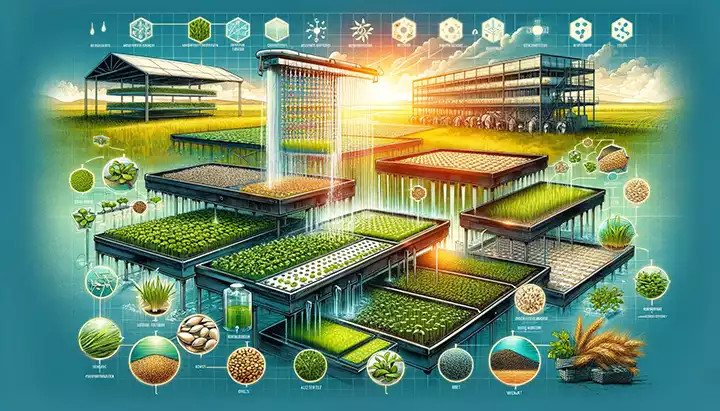Hydroponic fodder is revolutionizing the way farmers and livestock owners think about animal feed. This innovative method allows for the growth of seedlings into nutritious fodder without the need for soil, utilizing minimal water and space, and completely bypassing the need for chemical fertilizers or pesticides. Not only is hydroponic fodder a sustainable choice for the environment, but it also offers a fast, efficient, and nutrient-packed feed option for animals. Here’s a detailed guide on what hydroponic fodder is and how you can start producing it.

Understanding Hydroponic Fodder
Hydroponic fodder is essentially the process of growing plants from seeds in a water-based, nutrient-rich solution, without soil. The technique is particularly suited for producing high-quality animal feed. It grows quickly, usually within 7 days from seeding to harvest, and the resulting green shoots and root mat are consumed entirely by the animals. This method is ideal for regions facing water scarcity, reduced grazing land, or those looking to produce feed year-round.
Advantages of Hydroponic Fodder
- Fast Growth Cycle: Ready for harvest in just 7 days.
- High Nutrient Value: Rich in vitamins, minerals, and enzymes.
- Water Efficiency: Uses significantly less water than traditional fodder cultivation.
- Space Saving: Requires less space, making it perfect for small farms or urban settings.
- Year-Round Production: Can be grown in any climate, any time of the year.
- No Chemicals Required: Grows without the need for pesticides or fertilizers.
Step-by-Step Guide to Growing Hydroponic Fodder
Materials Needed:
- Seeds (oats, barley, alfalfa, sorghum, clover, wheat, cowpea, etc.)
- Hydroponic trays or containers
- Watering system (manual spray bottle or automated system)
- High-quality water
- Optional: Nutrient solution for hydroponics
Steps:
1. Seed Selection and Preparation:
- Choose high-germination, mold-resistant seeds.
- Soak the seeds in clean water for 8-24 hours to initiate germination.
2. Setting Up the Trays:
- Arrange clean hydroponic trays in a well-lit area, ensuring they have proper drainage.
- After soaking, spread the seeds evenly across the tray. Do not overcrowd to ensure even growth.

3. Watering:
- Initially, water the seeds lightly to maintain moisture without waterlogging.
- Set up a watering schedule that keeps the seeds moist but not soaked. Automated systems can simplify this process.
4. Germination and Growth:
- Seeds will start to sprout within the first few days. Ensure they receive ample light and consistent moisture.
- Maintain a clean environment to prevent mold or fungal growth.
5. Harvesting:
- Within 7 days, the fodder will be about 30 cm tall and ready for harvest. The entire mat of roots and shoots is edible.
- Cut the fodder close to the base to harvest, and feed it fresh to the animals.
6. Maintenance and Repeat:
- Clean the trays thoroughly after each cycle to prevent disease.
- Begin the process again for a continuous supply of fresh fodder.

Hydroponic fodder presents a sustainable and efficient solution to the challenges of producing quality animal feed, especially in areas with limited resources. By following the steps outlined above, farmers can secure a dependable source of nutritious feed that promotes the health and productivity of their livestock. As the method gains popularity, it has the potential to significantly impact agricultural practices, contributing to a more sustainable and self-sufficient farming future.
